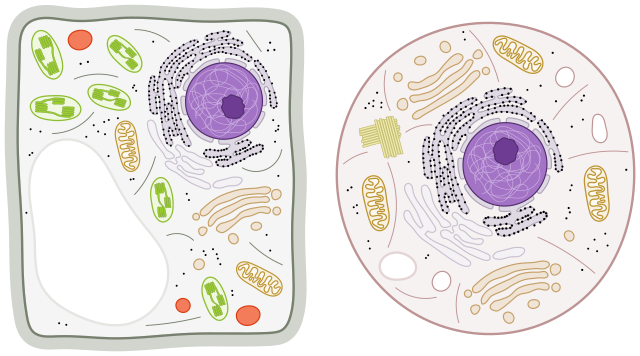Comparing Plant and Animal Cells
Plant cells and animal cells are both eukaryotic cells, meaning they have a true nucleus and membrane-bound organelles, but there are some key differences between the two. Here's a comparison of plant and animal cells:

-
Cell Wall:
- Plant Cell: Plant cells have a rigid cell wall composed primarily of cellulose. The cell wall provides structural support and protection.
- Animal Cell: Animal cells lack a cell wall. Instead, they are surrounded by a flexible plasma membrane.
- Chloroplasts:
- Plant Cell: Plant cells contain chloroplasts, which are responsible for photosynthesis, the process of converting sunlight into energy.
- Animal Cell: Animal cells do not contain chloroplasts. They are incapable of photosynthesis.
- Vacuole:
- Plant Cell: Plant cells typically have a large central vacuole that stores water, nutrients, and waste products. It also plays a role in maintaining turgor pressure.
- Animal Cell: Animal cells have smaller and sometimes multiple vacuoles, which are primarily involved in storage and transport of substances.
- Lysosomes:
- Plant Cell: Plant cells may have lysosomes, but they are less common. Lysosomes contain enzymes for digestion and waste removal.
- Animal Cell: Animal cells commonly contain lysosomes, which are essential for intracellular digestion and recycling.
- Centrioles:
- Plant Cell: Plant cells lack centrioles, which are involved in cell division (mitosis and meiosis) and the organization of microtubules during cell division.
- Animal Cell: Animal cells have centrioles, which are essential for the formation of the spindle fibers during cell division.
- Shape:
- Plant Cell: Plant cells often have a more regular and rectangular shape due to the rigid cell wall.
- Animal Cell: Animal cells have a more varied and irregular shape.
- Mobility:
- Plant Cell: Plant cells are generally stationary and do not exhibit mobility.
- Animal Cell: Animal cells are often mobile, and they can move and change shape.
- Energy Storage:
- Plant Cell: Plant cells store excess energy in the form of starch.
- Animal Cell: Animal cells store excess energy in the form of glycogen.
- Cilia and Flagella:
- Plant Cell: Plant cells do not have cilia or flagella.
- Animal Cell: Some animal cells, such as those in the respiratory tract, may have cilia for movement, and sperm cells have flagella for propulsion.
Plant and Animal Cell Resources
Comparing Plant and Animal Cells
Cheek Cell Lab – observe cheek cells under the microscope
Observing Plant Cells – microscope observation of onion and elodea
Investigation: What are the Different Types of Cells – survey of different kinds of cells, cheek, blood, onion root, leaf